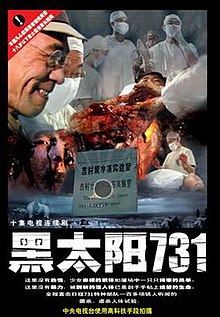Men Behind the Sun
| Men Behind the Sun | |
|---|---|
 Men Behind the Sun theatrical poster | |
| Directed by | Mou Tun-fei |
| Written by | Mou Tun-fei |
| Produced by | PRC |
| Starring | Hsu Gou Gang Wang Andrew Yu |
| Distributed by | Japan Shock (Netherlands) |
Release dates | Hong Kong December 1, 1988 |
Running time | 105 min. |
| Country | Hong Kong |
| Language | Mandarin |
| Budget | Unknown |
Men Behind the Sun (Chinese: 黑太阳731 / 黑太陽731; pinyin: hēi tài yáng 731, literally meaning "Black Sun: 731") is a 1988 Hong Kong film directed by Mou Tun-fei.
The film is a graphic depiction of the war atrocities committed by the Japanese at Unit 731, the secret biological weapons experimentation unit of the Imperial Japanese Army during World War II. The film details the various cruel medical experiments Unit 731 inflicted upon the Chinese and Soviet prisoners towards the end of the war.
This is the first movie to be rated "III" (equivalent to the US rating NC-17) in Hong Kong.
Plot
The movie opens with the passage "Friendship is friendship; history is history." Mou said of the quote, "that's the argument [I had] with the [Chinese] government, because the government says 'no, we have a friendship with the Japanese', I said 'well, you can talk about your friendship, I am talking about history.'"[1]
The film follows a group of Japanese boys who have been conscripted into the Youth Corps. They are assigned to the Kwangtung Army, and are brought to one of the facilities serving Unit 731, which is headed by Shiro Ishii. Soon, they are introduced to the experiments going on at the facility, for which they feel revulsion. The purpose of the experiments is to find a highly contagious strain of bubonic plague, to be used as a last-ditch weapon against the Chinese population.
Meanwhile, the young soldiers befriend a local mute Chinese boy with whom they play games of catch. One day, the commanding officers ask the boys to bring the Chinese child to the facility. Naïvely, they follow orders believing that no real harm will come to the boy. However, the senior medical staff places the boy in surgery for the purpose of harvesting his organs for research. When the young soldiers realize what has happened, they stage a minor uprising by ganging up and physically beating their commanding officer.
As the war goes on, the situation becomes increasingly desperate for the Japanese, and therefore Unit 731. In one of their last experiments, they tie a number of Chinese prisoners to crosses, intending for them to be used as targets for a prototype ceramic bomb containing infectious fleas. However, they are not able to contact their airfield due to a retreat. The Chinese prisoners break free from the crosses, and attempt to escape. However, the Japanese troops hunt them down, and nearly all of them are run over or shot. Several Japanese are also killed or injured.
Returning to the facility after the aborted experiment, there is no more time left for Unit 731 and they are forced to destroy their research and all other evidence of the atrocities happening there. Dr. Ishii initially orders his subordinates and their families to commit suicide, but is persuaded instead to evacuate them and only commit suicide if captured. However, he makes it clear that secrecy is to be maintained, with dire consequences.
The Japanese troops gather at a train station to be transported out of China. One of the Chinese prisoners, having disguised himself and escaped with a group of soldiers, is discovered by an officer. During a short scuffle in which he kills the officer before being killed himself, his blood stains the Japanese flag, to the horror of the Youth Corps. The train leaves the station.
The closing passages reveal that Dr. Ishii cooperates with the Americans, giving them his research and agreeing to work for them. Years later, he is moved to the Korean front, and biological weapons appear on the battlefield shortly thereafter.
Controversy
Though Mou claims he was trying to depict historical accuracy with the film,[2][3] he has been criticized that the film's appearance as an exploitation film negates any educational value.[4][5][6]
Because of its graphic content, the film has suffered mass controversy with censors all over the world. It was originally banned in Australia[7] and caused public outcry in Japan to such an extent that director T.F. Mou even received threats on his life.[3]
The film is extremely controversial for its use of what Mou claims to be actual autopsy footage of a young boy and also for a scene in which a live cat appears to be thrown into a room to be eaten alive by hundreds of frenzied rats.[8] In a scene later in the movie, live rats were set on fire, which drew criticism for its cruelty in many countries.
Sequels
The movie spawned three pseudo-sequels:
- Laboratory of the Devil (黑太陽731續集之殺人工廠, 1992)
- Narrow Escape (死亡列車, 1994)
- Black Sun: The Nanking Massacre (黑太陽─南京大屠殺, 1995)
See also
References
- ^ Black Sunshine: Conversations with T.F. Mou
- ^ "Interview-Tun Fei Mou". HorrorView.com. Retrieved 2006-12-16.
- ^ a b Donato Totaro. "T.F. Mous - The Man Behind the Sun". Horschamp.qc.ca. Retrieved 2006-12-16.
- ^ Robert Firsching. "Man Behind the Sun". All Movies Guide. Retrieved 2006-12-16.
- ^ Mike Bracken. "Men Behind the Sun (1987)". Epinions. Retrieved 2006-12-16.
- ^ "Camp 731 - Critique et photos". OhMyGore.com. Retrieved 2006-12-16.
- ^ "Man Behind the Sun 1 & 2". Refused-Classification.com. Retrieved 2006-12-16.
- ^ Hawker, Philippa (2004-04-23). "The Man Behind th Sun". The Age. Retrieved 2009-01-03.
